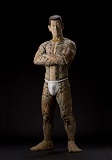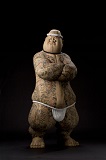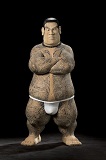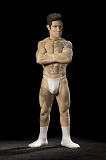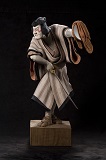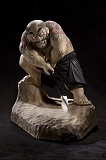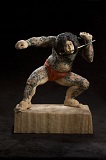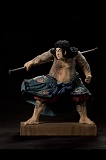Takeshi HAGURI ExhibitionMay 14 Wed. - May 31 Sat. 2014 |
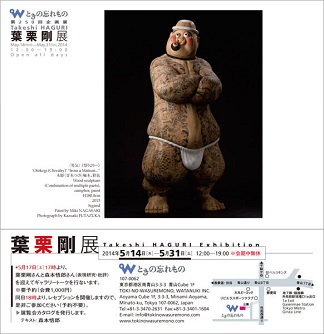 |
||
Toki-no-Wasuremono presents the exhibition by Nagoya based wood sculptor Takeshi HAGURI.
In this exhibition, we are presenting 7 works by the sculptor, including 2 masterpieces from series 'Otokogi (Chivalry)'.
This is the first time for us to hold sculptor's solo exhibition.
The earliest of Haguri's work I am familiar with is his 'Musicians' series from the early 1990s. The musicians are carved in a modern, popular style, and have a cheerful energy to them. Toward the latter half of the 1990s, Haguri began working on a series depicting the delinquent youths known in Japan as 'Yankees'. This time, the gures —motorcycle gang members brandishing wooden swords, or men squatting slovenly for a smoke —have a somewhat more carefree air than the musicians, but they are still not desperately serious in feel. Crossing over into the 2000s, Haguri upped his game to tackle gangsters and members of the yakuza as part of his‘Outlaws’series, and here the frowning men have a distinct darkness hanging over them. It was around that time that tattoos made an appearance in Haguri's work. Interestingly, two years after that, the artist started to look to Buddhist subject matter as inspiration for sculptures such as his rendition of the lantern-bearing Tentoki devil from Kofuku-ji Temple—though this was de nitely not an attempt to compensate for the tattoos. Into the 2010s, and the tattoos now also appear on the bodies of those carrying the portable mikoshi shrines at matsuri, or festivals. The tattoos are created by Haguri's apprentice and assistant, Miki Nagasaki —whose own works, it is worth noting here, also merit attention.
Both the 'Outlaws' and the 'Matsuri' series are still ongoing, but in 2013 Haguri also began creating sculptures that take gures appearing in works of art from the Edo period (1603-1867), such as Soga Shohaku's The Daoist Immortal Li Tieguai (Museum of Fine Arts, Boston Collection) and Kuniyoshi Utagawa's Lu Zhishen from his One Hundred and Eight Heroes of the Popular Suikoden, and bring them into three dimensions. Although techniques have differed between the East and the West, the fundamental concern of painting has been to develop a host of techniques so as to better recreate three-dimensional reality on a at surface. Haguri's idea, though admittedly not his originally, is to reverse this process. The task calls for the ability to imagine with clarity the reverse and side-on views of people who appear only from the front in the picture.
From ("Haguri's Work" by Goro MORIMOTO in 'Takeshi Haguri Exhibition' catalogue
published by Toki-no-Wasuremono, 2014)
Translated by Polly BARTON
published by Toki-no-Wasuremono, 2014)
Translated by Polly BARTON
■Takeshi HAGURI (1957-)
Born 1957 in Nagoya, Japan. After graduating the Sculpture course at the Aichi University of the Arts in 1982, he moved on to a postgraduate course, graduating in 1984. Sine then he has been sculpting wood mainly, using aluminium for outdoor works. He held solo exhibitions at Gallery Muramatsu (1996,1998/Tokyo), Art Gallery C. SQUARE (2006/Nagoya), Andersen Park Children's Museum (2009/Chiba, Japan) and many others. As for group exhibitions, he took part in shows such as Kobe Figurative Sculpture Grand Prize Exhibtion (1996/Kobe, Japan), Vogtland International Sculpture Symposium (2000/Germany), Fugaku Biennale (2001/Shizuoka Prefectural Museum of Art, Japan) and 16th Taro Okamoto Modern Art Prize Exhibition (2013/ Taro Okamoto Museum of Art, Japan).His works are on display at Nisshinnishi High School (Aichi, Japan), Haruno Fureai Park (Shizuoka, Japan), Ijiramura Sports Park (Gifu, Japan), Nishiharu High School (Aichi, Japan), Saya Primary School (Aichi, Japan), Nagakute North Primary School (Aichi, Japan).
<Takeshi HAGURI Exhibition> works list
May 14 Wed. - May 31 Sat. 2014
Gallery View
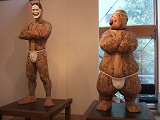 |
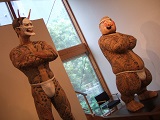 |
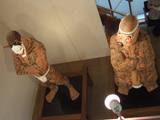 |
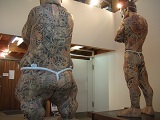 |
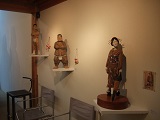 |
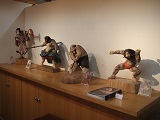 |
For price, more information and orders, please contact us via our inquiry form or e-mail us.

